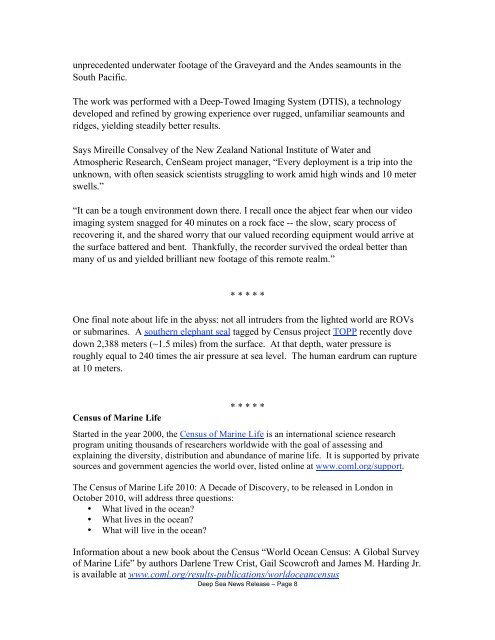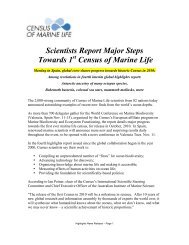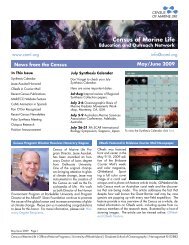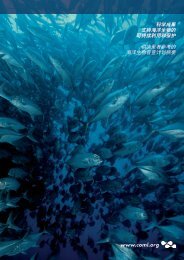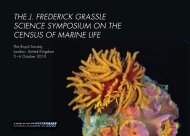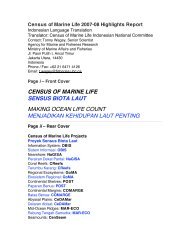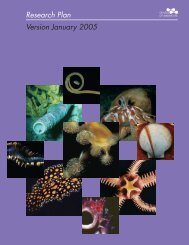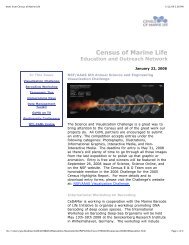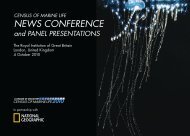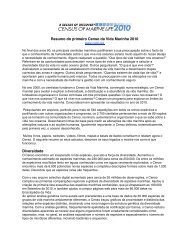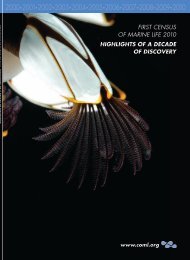From the Edge of Darkness to the Black Abyss - Census of Marine Life
From the Edge of Darkness to the Black Abyss - Census of Marine Life
From the Edge of Darkness to the Black Abyss - Census of Marine Life
You also want an ePaper? Increase the reach of your titles
YUMPU automatically turns print PDFs into web optimized ePapers that Google loves.
unprecedented underwater footage <strong>of</strong> <strong>the</strong> Graveyard and <strong>the</strong> Andes seamounts in <strong>the</strong>South Pacific.The work was performed with a Deep-Towed Imaging System (DTIS), a technologydeveloped and refined by growing experience over rugged, unfamiliar seamounts andridges, yielding steadily better results.Says Mireille Consalvey <strong>of</strong> <strong>the</strong> New Zealand National Institute <strong>of</strong> Water andAtmospheric Research, CenSeam project manager, “Every deployment is a trip in<strong>to</strong> <strong>the</strong>unknown, with <strong>of</strong>ten seasick scientists struggling <strong>to</strong> work amid high winds and 10 meterswells.”“It can be a <strong>to</strong>ugh environment down <strong>the</strong>re. I recall once <strong>the</strong> abject fear when our videoimaging system snagged for 40 minutes on a rock face -- <strong>the</strong> slow, scary process <strong>of</strong>recovering it, and <strong>the</strong> shared worry that our valued recording equipment would arrive at<strong>the</strong> surface battered and bent. Thankfully, <strong>the</strong> recorder survived <strong>the</strong> ordeal better thanmany <strong>of</strong> us and yielded brilliant new footage <strong>of</strong> this remote realm.”* * * * *One final note about life in <strong>the</strong> abyss: not all intruders from <strong>the</strong> lighted world are ROVsor submarines. A sou<strong>the</strong>rn elephant seal tagged by <strong>Census</strong> project TOPP recently dovedown 2,388 meters (~1.5 miles) from <strong>the</strong> surface. At that depth, water pressure isroughly equal <strong>to</strong> 240 times <strong>the</strong> air pressure at sea level. The human eardrum can ruptureat 10 meters.<strong>Census</strong> <strong>of</strong> <strong>Marine</strong> <strong>Life</strong>* * * * *Started in <strong>the</strong> year 2000, <strong>the</strong> <strong>Census</strong> <strong>of</strong> <strong>Marine</strong> <strong>Life</strong> is an international science researchprogram uniting thousands <strong>of</strong> researchers worldwide with <strong>the</strong> goal <strong>of</strong> assessing andexplaining <strong>the</strong> diversity, distribution and abundance <strong>of</strong> marine life. It is supported by privatesources and government agencies <strong>the</strong> world over, listed online at www.coml.org/support.The <strong>Census</strong> <strong>of</strong> <strong>Marine</strong> <strong>Life</strong> 2010: A Decade <strong>of</strong> Discovery, <strong>to</strong> be released in London inOc<strong>to</strong>ber 2010, will address three questions:• What lived in <strong>the</strong> ocean?• What lives in <strong>the</strong> ocean?• What will live in <strong>the</strong> ocean?Information about a new book about <strong>the</strong> <strong>Census</strong> “World Ocean <strong>Census</strong>: A Global Survey<strong>of</strong> <strong>Marine</strong> <strong>Life</strong>” by authors Darlene Trew Crist, Gail Scowcr<strong>of</strong>t and James M. Harding Jr.is available at www.coml.org/results-publications/worldoceancensusDeep Sea News Release – Page 8


